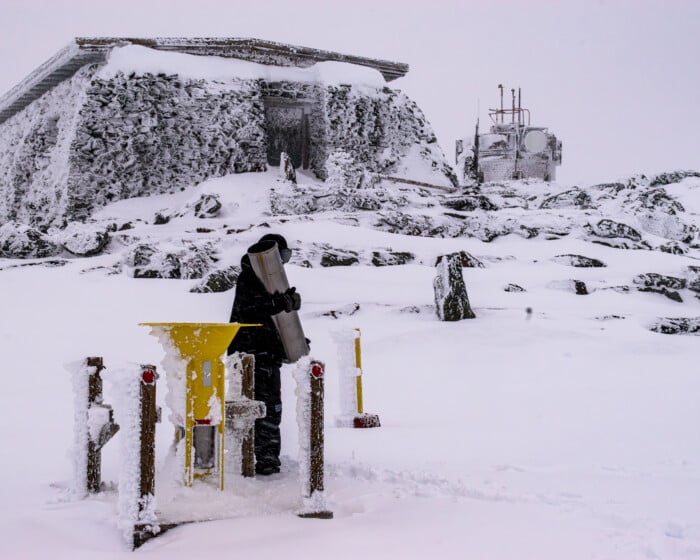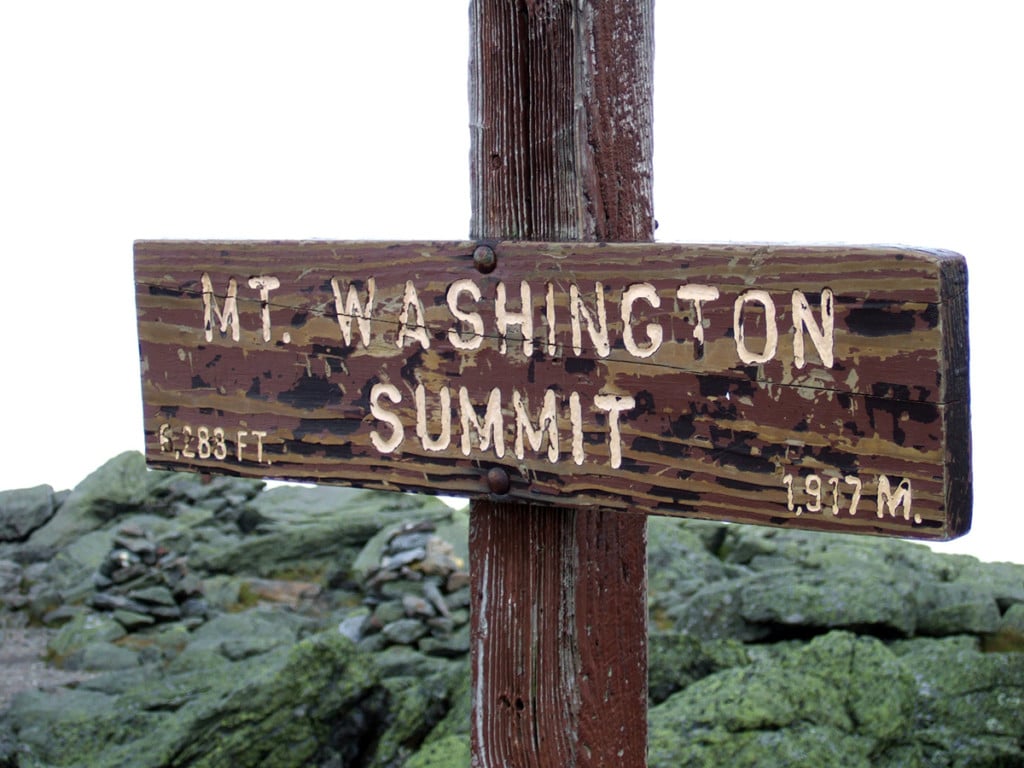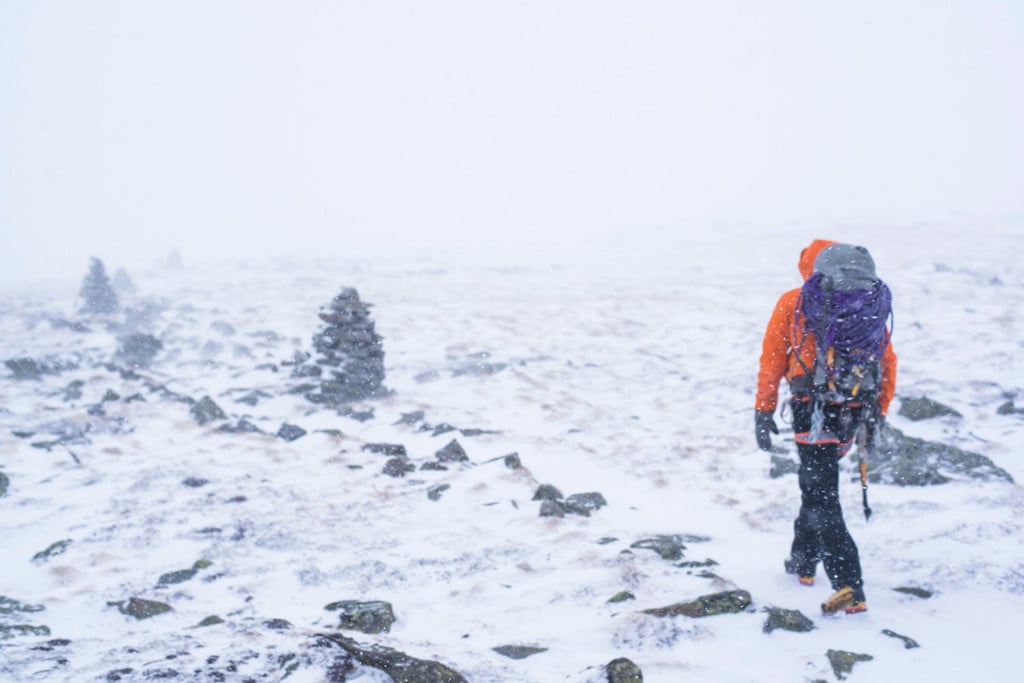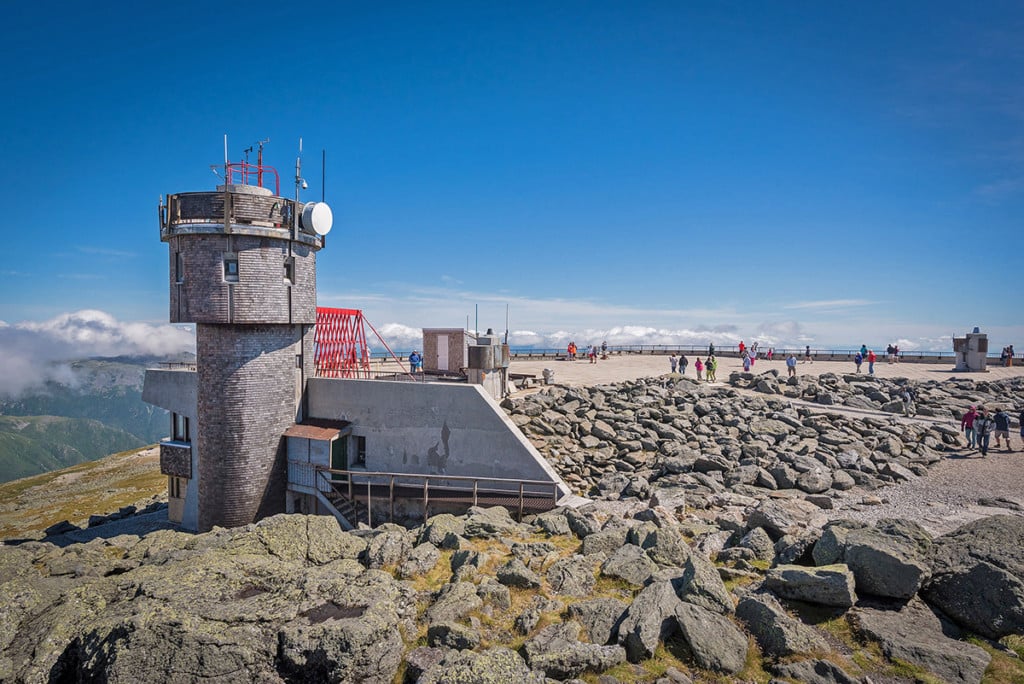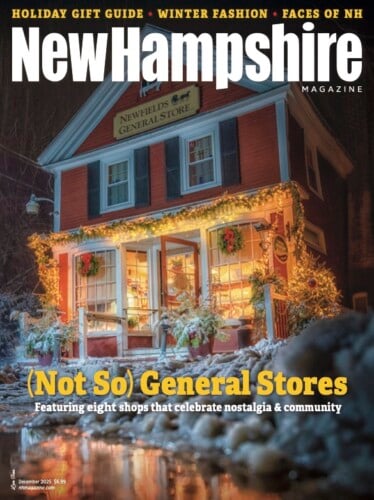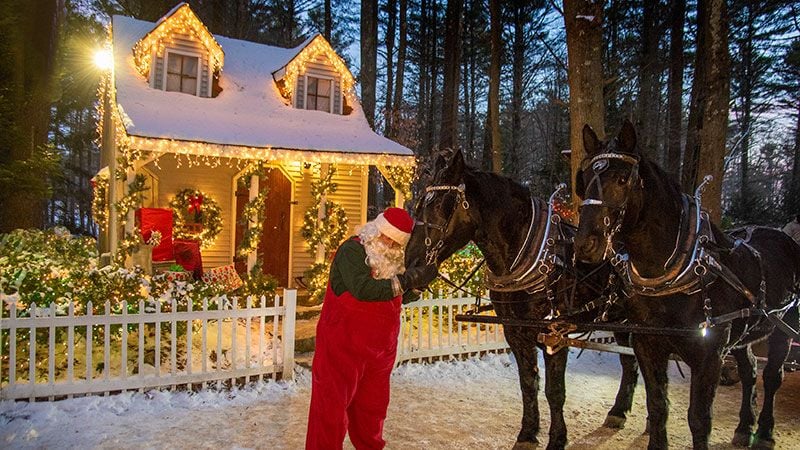Mt. Washington: Where the Wind Never Sleeps
Meet the summit scientists at the Mt. Washington Observatory who study Mt. Washington's famed wild weather and record breaking winds
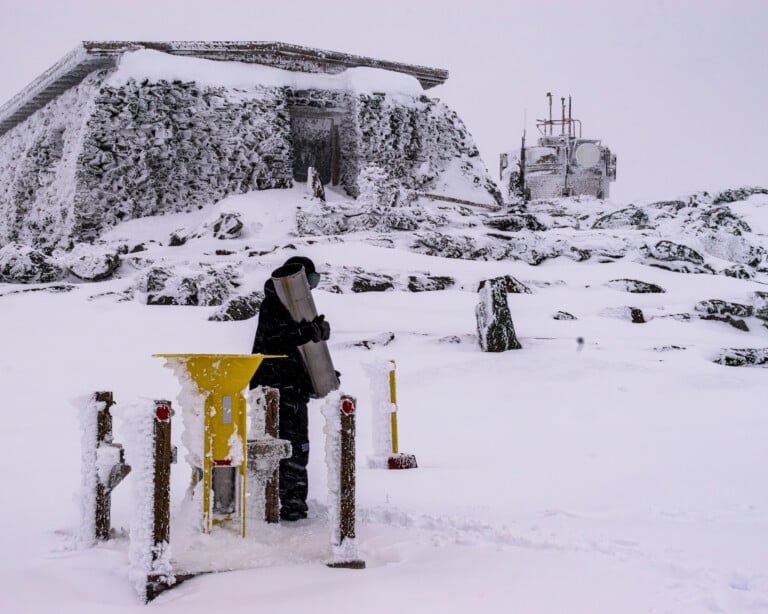
The summer solstice on June 20 dawned sunny and warm in most of New Hampshire this year. But in Sargent’s Purchase, about 100 miles north of the Seacoast, hurricane-force wind gusts and 30-degree temperatures were forecast to ravage Mount Washington at its peak, 6,288 feet up.
Mike Carmon, summit weather operations manager for the Mount Washington Observatory, says on that day elevated wind speeds from an unseasonably strong system were recorded. When it was over, a maximum wind speed of 124 mph, the fourth highest peak wind gust observers have ever seen in the month of June, was lodged in the books.
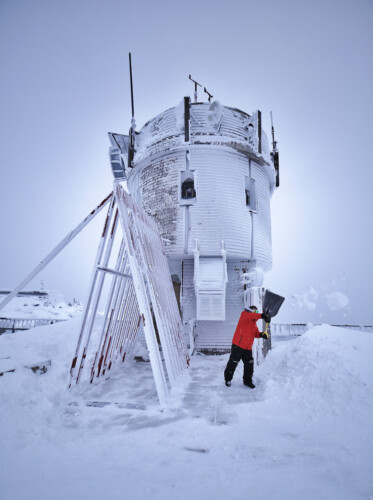
A weather observer shovels the observation deck in winter; the triangular structure to the left protects people from falling ice overhead. Observers must go out hourly to report on forecasting and perform quality checks, as well as keep equipment free of snow and ice. Photo by Ryan Knapp / Mt. Washington Observatory
“It was a pretty unique event. Normally, our windiest months are in the wintertime,” Carmon says.
Weather observers here, on the tallest peak in the northeastern U.S., are rarely caught off-guard. In fact, they expect hurricane-force wind gusts for about 110 days a year.
Some of the most powerful weather conditions on Earth routinely exist on Mount Washington, and it’s right in our own backyard. No wonder scores of locals, tourists and hikers traverse its trails, attempt to drive the 7.6-mile-long Mt. Washington Auto Road for bumper-sticker bragging rights, or ride the Cog Railway for a pain-free trip to the top.
“We see 300,000 visitors in total each operating season, but it’s really an estimate at best,” says Patrick Hummel, park supervisor for Mount Washington State Park.
About 140,000 people reach the summit on the Cog, about 125,000 people take the Auto Road every season, and an estimated 75,000 people hike the mountain every year, Hummel says, adding that “tens of millions” have been up and down these trails.
All those footprints could do some sizeable damage to Mount Washington’s delicate ecosystem, but park staff make sure hikers stay on designated paths to preserve the flora and fauna here for future generations.
“It is vital to the future of the summit, especially regarding tourism and development, that the alpine vegetation is protected,” Hummel says.
Safety and education have been the priority for everyone who works there.
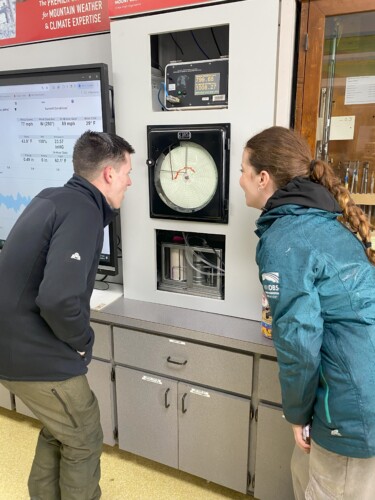
Summit interns Madelynn Smith and Max Sasser watch the Hays Chart for gusts of over 100 mph on June 20. The Hays Chart records 24-hour wind speeds with an inked needle rotating on an axis. Photo Courtesy/ Mt. Washington Observatory
For 155 years, hundreds of observers like Carmon have delivered accurate forecasts in challenging, often rapidly changing conditions, all in the name of keeping visitors safe and informed.
Research on the mountain began during the winter of 1870-1871, when observers used the telegraph to deliver forecasts to the region.
The observatory’s first home was a circa-1908 office of the Mount Washington Summit Road Company, where researchers collaborated with the Appalachian Mountain Club to inform hikers. The observatory was founded as a private nonprofit in 1932.
Today, at least three observers alternate 12-hour shifts from 5 a.m. to 5 p.m., (with another on the night shift) 24 hours a day, 365 days a year, to take readings, measure data and update forecasts hourly from the Sherman Adams Summit Building at Mount Washington State Park.
The observatory issues statewide forecasts for New Hampshire and Vermont and publishes the Mount Washington Valley Regional forecast where the team collaborates with local radio groups and each Friday night, conducts Facebook Live forecasts. A higher-summits forecast is released twice a day.
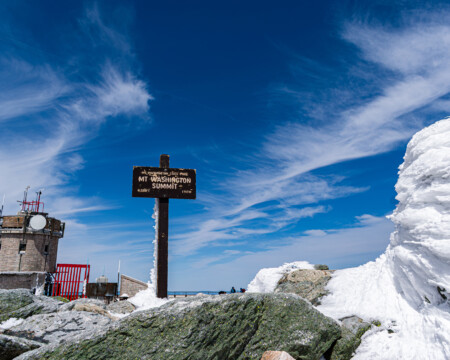
Mount Washington State Park’s summit sign marks the elevation (6,288 feet), and serves as a popular photo-taking spot at the top. Photo Courtesy/ Mt. Washington Observatory
None of the information goes to waste.
“That data will not only go into our over 90-year climate data set, but it will also go into the National Weather Service’s data, which helps to inform their forecasting models. The more data we have into those models, the better those models are going to be,” says weather observer and education specialist Amy Cotter of Bartlett adds.
While not every weather report is as record-breaking as the events of June 20, the observatory’s ongoing research continues to enhance an already rich treasure trove of data, says Cotter.
“We’re going outside collecting weather data, like precipitation, type, sky cover (what types of clouds are observed), temperature and wind speed, and we submit those observations on the hour to the National Weather Service. That’s our primary responsibility as weather observers,” Cotter says.
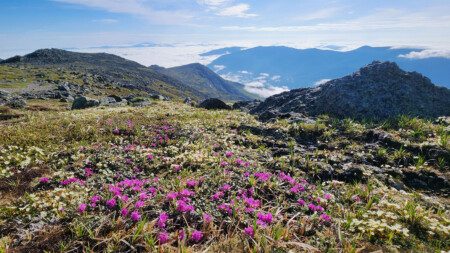
Park staff make sure hikers stay on designated paths to preserve Mount Washington’s delicate ecosystem of flora and fauna for future generations. Photo Courtesy/ Mt. Washington Observatory
Observers also perform outside maintenance, like scraping rime ice off the weather instruments on the instrument tower, in all situations.
“We do have to go outside every hour, no matter the conditions. The only exception would be if there is lightning. We are the tallest point within a nearly 800-mile radius, and our weather tower is made out of metal, so it’s basically like a big lightning rod,” Cotter says.
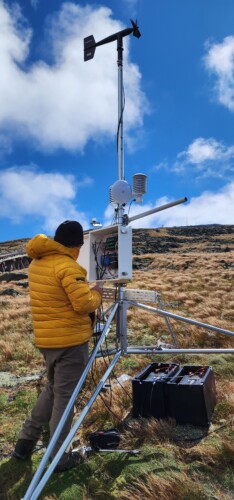
MWOBS Director of Technology Keith Garrett installs a remote weather station along the Mount Washington Cog Railway, one of five stations along the Cog’s vertical profile. Photo Courtesy/ Mt. Washington Observatory
Observers record their findings in blog posts, sharing their experiences and infectious excitement about the joys of working here.
During a two-day snowstorm from Feb. 3-4, 2023, a chilly temperature of -47 degrees was recorded around 3 a.m. on Feb. 4, matching the observatory’s 1934 record. Wind chills neared an otherworldly -110 degrees, and a peak wind gust of 127 mph was observed.
Carmon, a meteorologist who’s originally from New Jersey, says observers like to keep track of the highest wind gusts they personally experience.
“I think anybody who works at the observatory for any length of time has tracked what their highest wind speed is,” says Carmon, who recalls experiencing wind speeds of up to 133 mph when he was performing maintenance on the tower’s anemometers, which measure wind speed.
Carmon also remembers when the remnants of Hurricane Irene passed through in 2011.
“For me, 139 miles per hour is the strongest that I’ve ever experienced. I was not outside for that,” Carmon says.
But on April 12, 1934, two wind gusts nearly twice that velocity — 231 mph — roared over the rocks and steadfast vegetation. The highest wind ever recorded by man sent shockwaves through the meteorological world during only the Observatory’s second year. The event, known as the “Big Wind,” as observers call it on the blog, is commemorated by a weathered plaque on the summit. The record stood for more than 60 years.
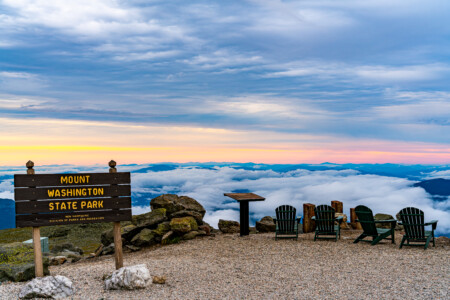
Sunlight breaks across the sky one morning as puffy clouds sit below the summit. Photo Courtesy/ Charlie Peachey/ Mt. Washington Observatory
Besides jaw-dropping wind speeds, monitoring temperature extremes is another cool perk.
“The coldest temperature I experienced up there, I believe it was -41 or -42 degrees,” Carmon says. The estimated wind chill was 100 degrees below zero.
Carmon says if observers are properly protected, they shouldn’t feel the elements, but severe wind and cold still finds a way.
“When you step outside into extreme cold, it almost feels like you’re getting in a bath of cold water. It’s just very all-consuming, he says. “Even if you are geared up, you feel it over your body. The wind sort of picks at your gear.”
Thanks to the mountain’s elevation, its position in the Presidential Range, and the jet stream, chaotic weather systems often “culminate” here.
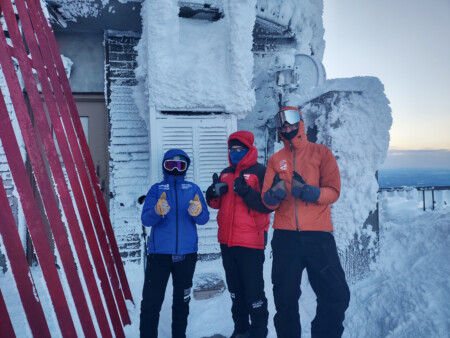
Weather observers Alexis George, Francis Tarasiewicz and Karl Philippoff after recording the record-low temperature on Feb. 4, 2023. Mt. Washington Observatory
“It’s fascinating. Because of where it’s situated, and the way the systems track, (it’s the) perfect storm for weather systems,” says Ellen Estabrook, communications manager for Mount Washington Observatory.
Technically, she says, Mount Washington isn’t home to the world’s most extreme weather, but it comes pretty close.
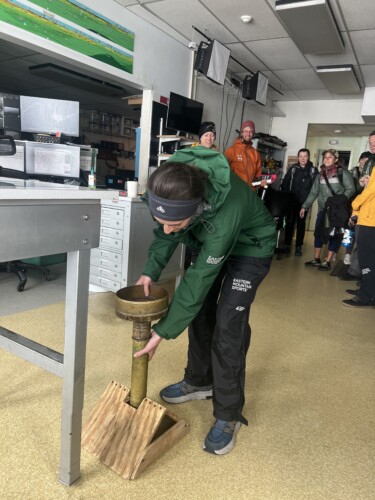
Weather observer and education specialist Alex Branton measures precipitation. Photo Courtesy/ Mt. Washington Observatory
“There’s not many places that have a combination of all of those things that we see so frequently for so much of the year,” Estabrook says.
Though not a meteorologist, Estabrook is still surprised by the summit’s unique climate and weather.
“On the mountain, the weather extremes come to you, and you can really just step outside and feel them,” Estabrook says.
She remembers getting “pushed around” by 60 mph winds.
“That was a phenomenon I’d never really experienced before, of just standing outside and getting knocked over by the wind. That was fascinating for me,” she says.
Estabrook works in a satellite office in North Conway, but visits the summit regularly to share information with the media and other groups about ongoing projects and changing weather conditions.
Estabrook says the observatory also offers educational and fun events for kids. For example, this is the second year it has offered a summer camp program called Storm Scouts in August. Kids in Grades 4 through 8 can learn about Mount Washington at the North Conway office, then visit the summit to better understand its weather, history and heritage. Students can chat live online with weather observers during the winter, when the summit is closed to most visitors.
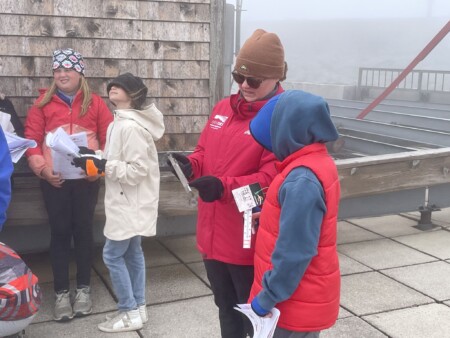
Weather observer and education specialist Amy Cotter shows a summer camp participant a tool that calculates relative humidity. Photo Courtesy/ Mt. Washington Observatory
Whether technically open or closed, research takes place here almost nonstop.
Now, with an existing data set that’s more than 90 years old, experts can help determine long-term weather changes. Several high-end research projects are constantly underway.
For example, a snow to-liquid-ratio analysis is measuring how the water content from melted snow changes over time.
“That can tell us a lot about the different types of air masses that may be producing snow on and around Mount Washington,” Carmon says.
Another research project analyzes whether “rain on snow events”— when snow on the ground warms up during a rainstorm and causes flooding — are becoming more frequent.
“We’ve had a couple of significant flooding events in the past couple years in New England, particularly ones where there’s snow on the ground, and we get big flooding because of it,” says Carmon says.

Nimbus, the summit’s resident cat, sits in the weather room as night observer Ryan Knapp gears up to go outside. Photo Courtesy/ Mt. Washington Observatory
UNH’s Space Science Center is even monitoring the strength of cosmic rays that reach the summit from outer space.
Meanwhile, Mount Washington State Park has been tracking the mountain’s rare flora and fauna through a comprehensive study that aims to include every plant in the state park’s almost 60 acres, says Hummel. That staff also collaborates with the White Mountain National Forest and volunteers to remove any invasive plant species.
Keeping the observer’s company is another brave, yet smaller creature: Nimbus the Summit Cat, a grey shorthair tabby who was originally named Greg. Nimbus was discovered in Oklahoma and was adopted after the summit’s previous cat, Marty, died in 2020.
Nimbus joins a long line of cats who have lived on the summit since 1932, when Tikky the cat blazed the trail as a rodent-catcher and companion to the weather observers. Other famous felines have included Inga, Oompha, Blackie, Ammonuisance, Elmer, Manx and George.
As a somewhat elusive mountain “spokescat,” Nimbus can sometimes be found strolling the Sherman Adams State Park Visitor Center or controlling the rodent population.
Besides the many research projects and the constant influx of visitors during the summer, the summit has a gift shop, cafeteria and museum. Weather station tours take place May 24 through mid-October.
